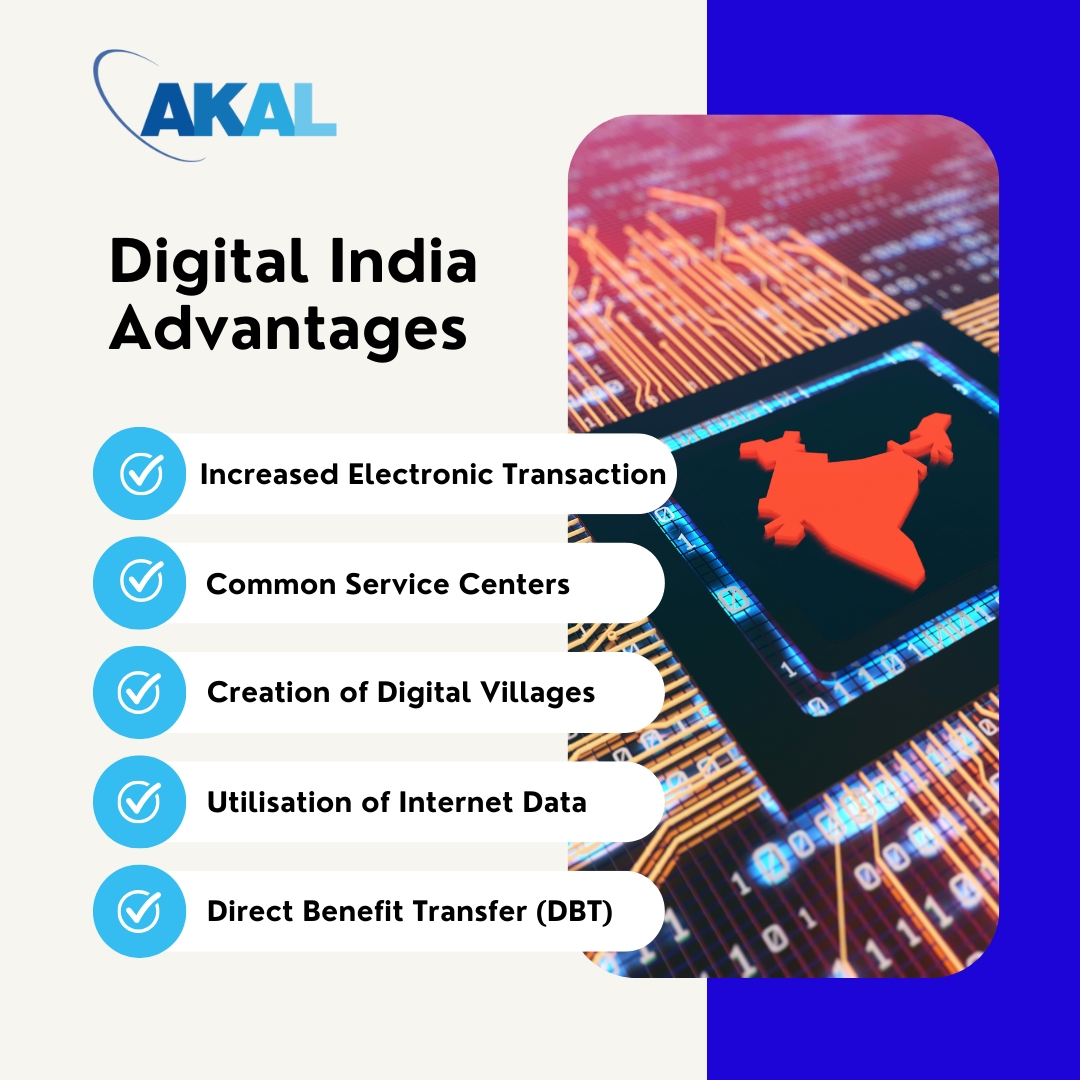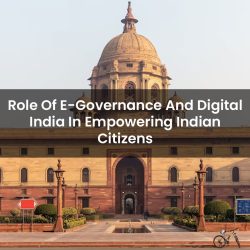In a bid to revolutionise accessibility to government services and bolster technological empowerment, the Indian Government initiated the Digital India campaign. Spearheaded by Prime Minister Narendra Modi, the campaign, launched on July 1st, 2015, seeks to enhance online infrastructure and internet connectivity, paving the way for a digitally empowered nation.
This article will talk about its objectives, advantages, schemes and much more.
What is Digital India?
Digital India, launched by Prime Minister Narendra Modi on July 1st, 2015, stands as a transformative initiative by the Government of India aimed at bridging the digital divide and fostering inclusive growth across the nation. It encompasses various schemes, including Make in India, Bharatmala, Sagarmala, Startup India, BharatNet, and Standup India, leveraging technology to propel progress in multiple sectors.
The mission of Digital India revolves around three key areas:
- Digital Infrastructure: Ensuring every citizen has access to digital utilities.
- Governance and Service Delivery: Facilitating on-demand access to government services.
- Digital Empowerment: Empowering every citizen through digital literacy and skills development.
With a vision of inclusive growth in electronic services, products, manufacturing, and employment opportunities, Digital India focuses on nine pillars of growth:
- Broadband Highways: Expansion of broadband connectivity in rural and urban areas.
- Universal Access to Mobile Connectivity: Enhancing network penetration across the country.
- Public Internet Access Programme: Establishing Common Services Centres (CSCs) and leveraging Post Offices as multi-service centres.
- E-Governance: Simplifying government processes through IT integration and reform.
- E-Kranti: Facilitating electronic delivery of services to improve accessibility and efficiency.
- Information for All: Ensuring transparency and availability of reliable data for public use.
- Electronics Manufacturing: Promoting domestic manufacturing of electronics.
- IT for Jobs: Providing skill development and training for employment opportunities in the IT/ITES sector.
- Early Harvest Programmes: Implementing short-term projects that immediately impact the digital ecosystem.
Through these pillars, Digital India aims to leverage technology as a catalyst for socio-economic development, empowering citizens and driving progress across various sectors of the Indian economy.
What are the Objectives of Digital India?
The Digital India Mission, guided by the motto ‘Power to Empower’, encompasses three core components: digital infrastructure creation, digital delivery of services, and digital literacy. With these pillars in mind, the initiative aims to achieve several key objectives:
- Universal High-Speed Internet: Ensuring access to high-speed internet in all gram panchayats across the country, bridging the digital divide and enabling connectivity in remote areas.
- Accessibility through Common Service Centers (CSCs): Facilitating easy access to Common Service Centers (CSCs) in every locality, providing citizens with convenient avenues for availing government services and digital resources.
- Comprehensive Vision: Integrating diverse ideas and initiatives into a unified vision, wherein each aspect contributes to a larger goal of digital empowerment and inclusive growth.
- Restructuring Existing Schemes: Streamlining and reorganising existing schemes to ensure synchronised implementation and maximise impact, thereby enhancing the effectiveness of government initiatives in the digital realm.
Digital India Advantages
The Digital India Mission is a transformative initiative aimed at connecting rural areas with high-speed internet networks, fostering digital inclusion, and propelling India’s digital economy forward. With the Public Internet Access Programme as one of its key pillars, Digital India holds several advantages:
- Increased Electronic Transactions: The initiative has led to a surge in electronic transactions related to e-governance, streamlining processes and enhancing efficiency in service delivery.
- Expanded Optical Fiber Network: Through the Bharat Net programme, over 1.15 lakh Gram Panchayats have been connected via an extensive optical fibre network spanning 2,74,246 kilometres, facilitating seamless internet connectivity in rural areas.
- Common Service Centers (CSCs): Under the National e-Governance Project, CSCs have been established across the country, offering access to a wide range of information and communication technology (ICT) services. These centres provide multimedia content, including e-governance services, education, health, telemedicine, and entertainment, contributing to digital empowerment at the grassroots level.
- Creation of Digital Villages: Digital India has spurred the establishment of digital villages equipped with essential amenities such as solar lighting, LED assembly units, sanitary napkin production units, and Wi-Fi choupals, empowering rural communities and bridging the digital divide.
- Utilisation of Internet Data: Internet data serves as a pivotal tool for service delivery, with urban internet penetration reaching 64%. This widespread connectivity enables citizens to access government and private services efficiently, fostering digital inclusion and empowerment.
Through these advantages, Digital India is driving socio-economic development, promoting digital literacy, and positioning India as a global leader in the digital realm.

Digital India Challenges
While the Digital India Mission strives to connect rural areas with high-speed internet networks, it faces several challenges hindering its progress. Some of these challenges and drawbacks include:
- Slow Internet Speed and Wi-Fi Hotspots: Compared to other developed nations, the daily internet speed and availability of Wi-Fi hotspots in India are often inadequate, limiting seamless connectivity and hindering digital access.
- Adoption Challenges for Small and Medium Enterprises (SMEs): Many small and medium-scale industries encounter difficulties in adapting to modern technology, often due to limited resources or technical expertise, impeding their integration into the digital ecosystem.
- Limitations of Entry-Level Smartphones: Entry-level smartphones commonly lack the capabilities required for smooth internet access, restricting the digital experience for users and hampering widespread adoption of digital services.
- Shortage of Skilled Manpower: The digital technology sector faces a shortage of skilled manpower, with a lack of adequately trained professionals proficient in digital technologies, posing a significant challenge to the implementation and maintenance of digital infrastructure and services.
- Cybersecurity Concerns: With the proliferation of digital platforms and transactions, there is a pressing need for cybersecurity experts to combat the growing menace of digital crimes. However, there is a shortage of approximately one million cybersecurity experts in India, highlighting a critical gap in addressing cybersecurity threats effectively.
- Lack of User Education: A significant challenge lies in the lack of user education regarding digital technologies and online safety practices. This hampers the adoption of digital services and exposes users to various risks and vulnerabilities.
Addressing these challenges is crucial for the successful implementation and sustainability of the Digital India Mission, requiring concerted efforts from government agencies, industry stakeholders, and educational institutions to overcome barriers and ensure inclusive digital empowerment for all citizens.
Initiatives Under Digital India
Under the Digital India campaign, the government has initiated several key projects aimed at enhancing digital empowerment and connectivity. Here are some noteworthy initiatives:
- DigiLockers: This flagship initiative facilitates ‘Digital Empowerment’ by providing citizens with access to authentic digital documents through a secure digital document wallet.
- E-Hospitals: A Hospital Management Information System (HMIS) designed to streamline patient, hospital, and doctor interactions through a unified digital platform. As of February 2021, 420 e-Hospitals have been established under Digital India, enhancing healthcare accessibility and efficiency.
- E-Pathshala: Developed by NCERT, e-Pathshala serves as a comprehensive educational platform, offering access to educational e-resources such as textbooks, audio, video, periodicals, and other print and non-print materials through both a website and mobile app.
- BHIM (Bharat Interface for Money): BHIM is a user-friendly app that simplifies payment transactions using the Unified Payments Interface (UPI), making digital payments simple, easy, and quick. This initiative aims to promote cashless transactions and financial inclusion across India.
These initiatives exemplify the government’s commitment to leveraging technology for the benefit of citizens, fostering digital literacy, enhancing healthcare services, and promoting financial inclusion and digital payments. Digital India continues to pave the way towards a digitally empowered nation through these efforts.
How has Digital India Impacted the Indian Population?
The Digital India campaign, launched in 2015, has made significant strides across various sectors, leaving a notable impact:
- Electronic Connectivity: Approximately 12,000 post office branches in rural areas have been electronically linked, improving access to essential services and fostering digital inclusion in remote regions.
- Growth in Electronic Manufacturing: The Make in India initiative, under the Digital India campaign, has bolstered the electronic manufacturing sector, driving domestic production and reducing dependence on imports.
- Economic Growth Potential: Projections indicate that the Digital India plan could potentially boost India’s GDP up to $1 trillion by 2025, underscoring its role as a catalyst for economic development and digital transformation.
- Advancements in Healthcare and Education: The campaign has led to advancements in the healthcare and education sectors, leveraging technology to enhance service delivery, promote digital literacy, and improve access to quality healthcare and educational resources.
- Strengthening Online Infrastructure: Continued investments in online infrastructure have not only facilitated digital connectivity but also have the potential to significantly enhance the country’s economy by enabling e-commerce, digital transactions, and remote work opportunities.
Overall, the Digital India campaign has demonstrated its impact across various facets of Indian society, laying the foundation for a digitally empowered nation and driving progress towards socio-economic development and inclusive growth.
FAQs about Digital India
What are the 9 pillars of Digital India?
The nine pillars of Digital India are Broadband Highways, Universal Access to Mobile Connectivity, Public Internet Access Programme, e-Governance: Reforming Government through Technology, e-Kranti – Electronic Delivery of Services, Information for All, Electronics Manufacturing, IT for Jobs, and Early Harvest Programmes.
What is the objective of Digital India?
The main objective of Digital India is to provide high-speed internet access across the country, enhance digital service delivery, and promote digital literacy.
What are the important initiatives under Digital India?
Important initiatives under Digital India include DigiLockers, E-Health Campaigns, E-Education Campaigns, E-Kranti (Electronic Delivery of Services), BHIM – UPI Portal, and E-Hospitals.
Who started Digital India?
Digital India was launched on July 1, 2015, by the Indian Prime Minister Narendra Modi.















